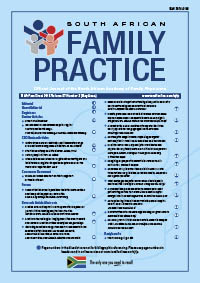Causes of prematurity in the Bloemfontein Academic Complex
Keywords:
Prematurity, Causes, morbidity, mortality
Abstract
Background: Prematurity is globally the leading cause of neonatal mortality, morbidity and long-term disability. The Millennium Development Goals (MDG) of the United Nations, and specifically MDG 4, address child mortality. Neonatal mortality rates contribute to 37% of all under-five mortality, with the largest proportion (30%) due to prematurity. The overall purpose of this study was to determine factors associated with prematurity and to identify treatable and preventable causes at the Bloemfontein Academic Complex in order to decrease the morbidity and mortality associated with prematurity in line with MDG. Methods: A case control study design was used including all premature babies referred to the Kangaroo Care Unit of the National District Hospital between December 2010 and March 2011. Each baby was included with his/her mother as a pair. For each premature baby and mother pair a term baby and mother pair was included as a control. Data were collected on a data sheet from the mothers’ antenatal records, and from maternal notes as well as the neonatal follow-up and discharge notes. Data gathered included baseline characteristics, habits, diseases and medication of the mother during the antenatal period and delivery as well as baseline demographics of the babies. Results: A total of 194 mothers and 198 babies were included in the study with 109 case mothers and 85 control mothers. Pre-existing medical conditions were more prevalent in the premature group (69%) compared with the control group (27%) with p < 0.0001. These conditions included hypertension, HIV disease and syphilis. Possible causes for prematurity identified in this study included teenage mothers and premature rupture of membranes. Conclusion: Risk factors identified for prematurity were: teenage mothers, pre-existing medical conditions in the mother, and preterm rupture of membranes. Smoking and alcohol consumption during pregnancy could not be identified as risk factors for prematurity. It is recommended that patients with any of the above-mentioned identified risk factors be classified as high risk for the development of prematurity and shorter follow-up intervals and more aggressive management of pre-existing medical conditions should be practised. (Full text available online at www.medpharm.tandfonline.com/ojfp) S Afr Fam Pract 2015; DOI: 10.1080/20786190.2014.976960
Published
2015-07-12
Section
Research Articles
By submitting manuscripts to SAFP, authors of original articles are assigning copyright to the South African Academy of Family Physicians. Copyright of review articles are assigned to the Publisher, Medpharm Publications (Pty) Ltd, unless otherwise specified. Authors may use their own work after publication without written permission, provided they acknowledge the original source. Individuals and academic institutions may freely copy and distribute articles published in SAFP for educational and research purposes without obtaining permission.

